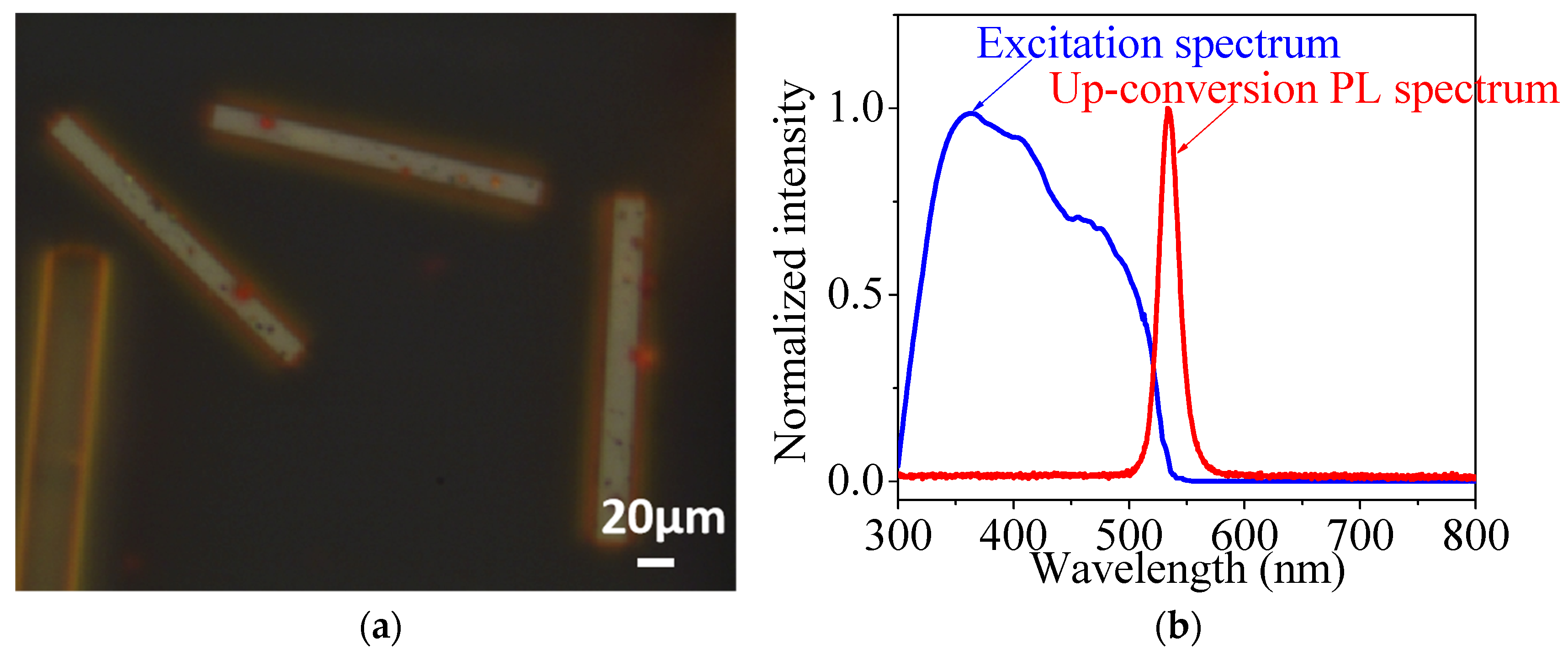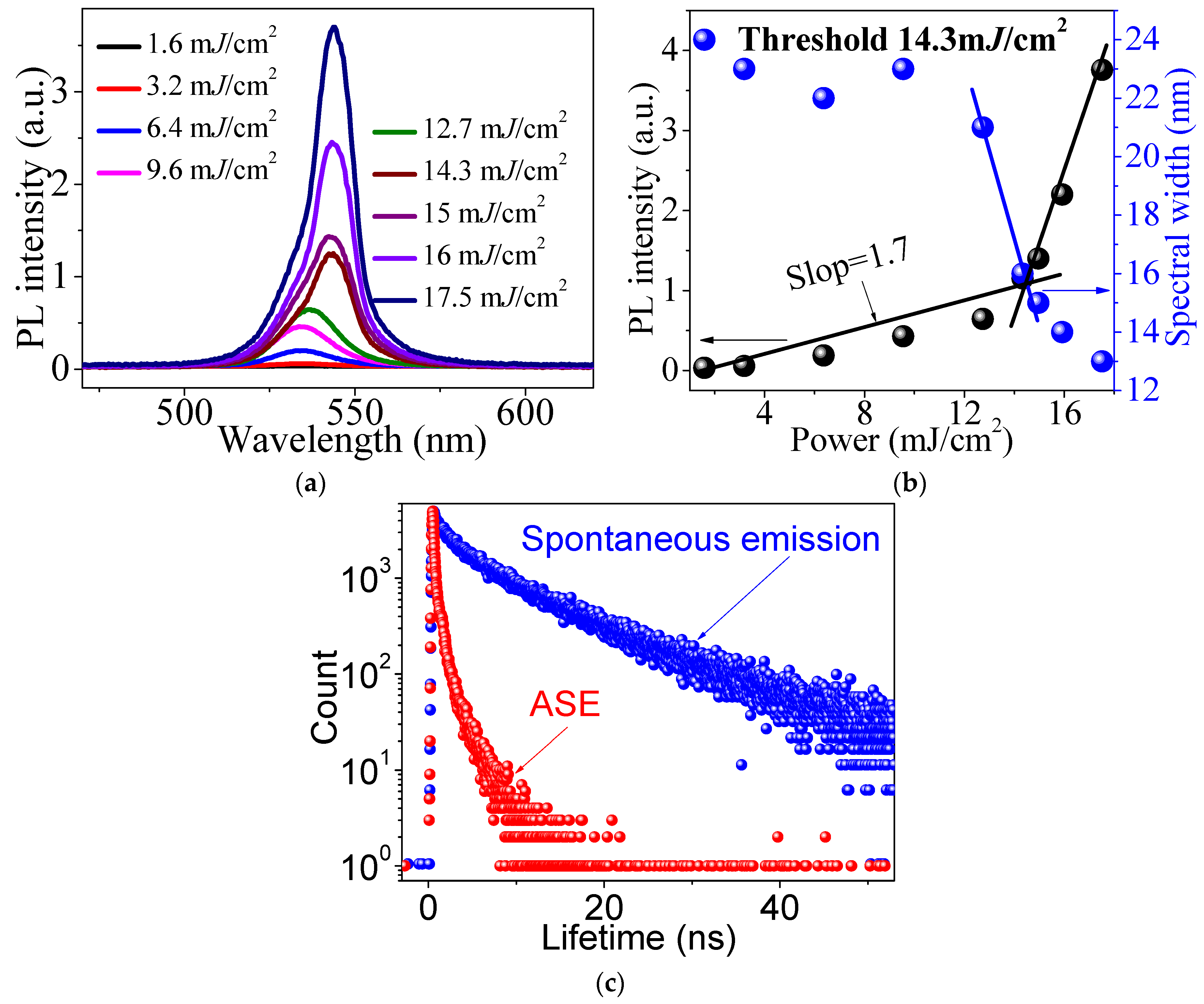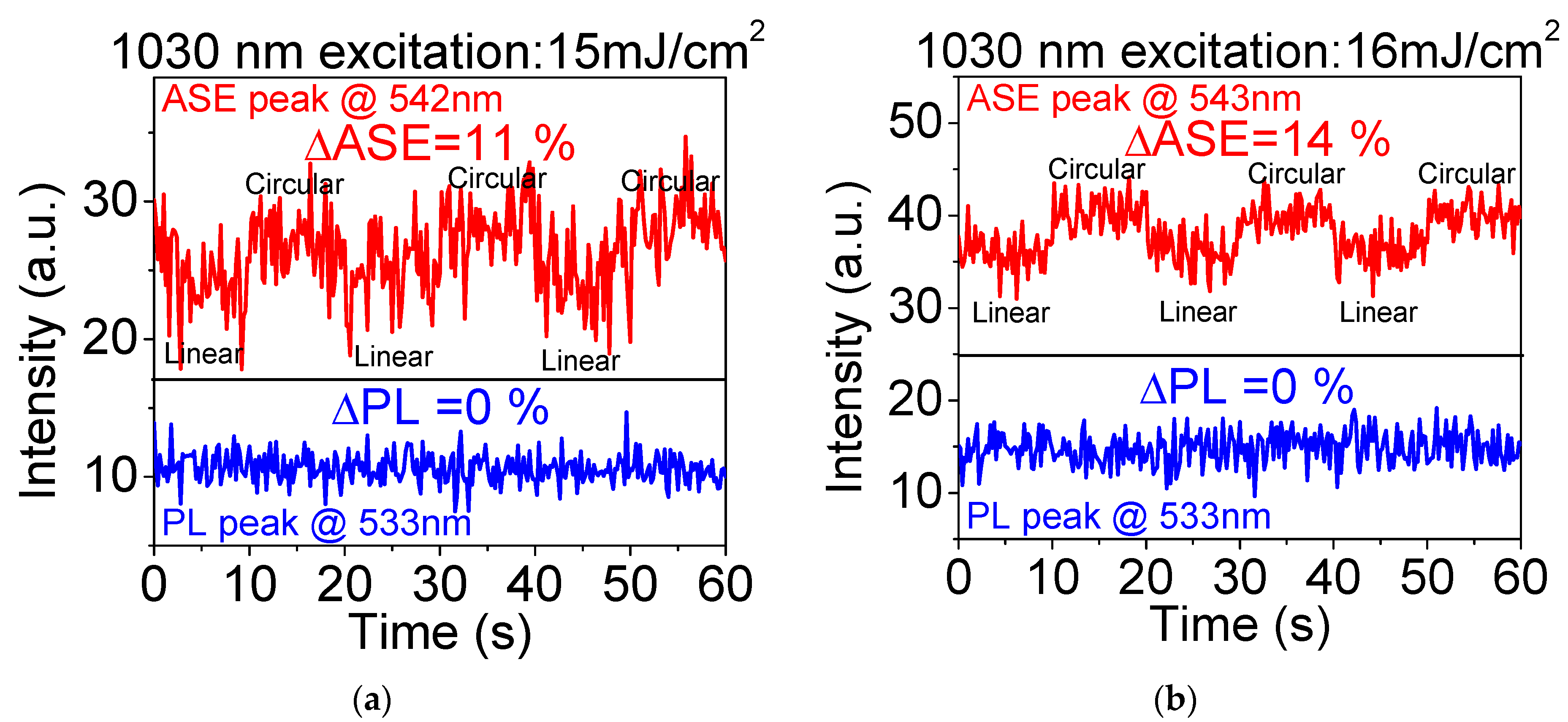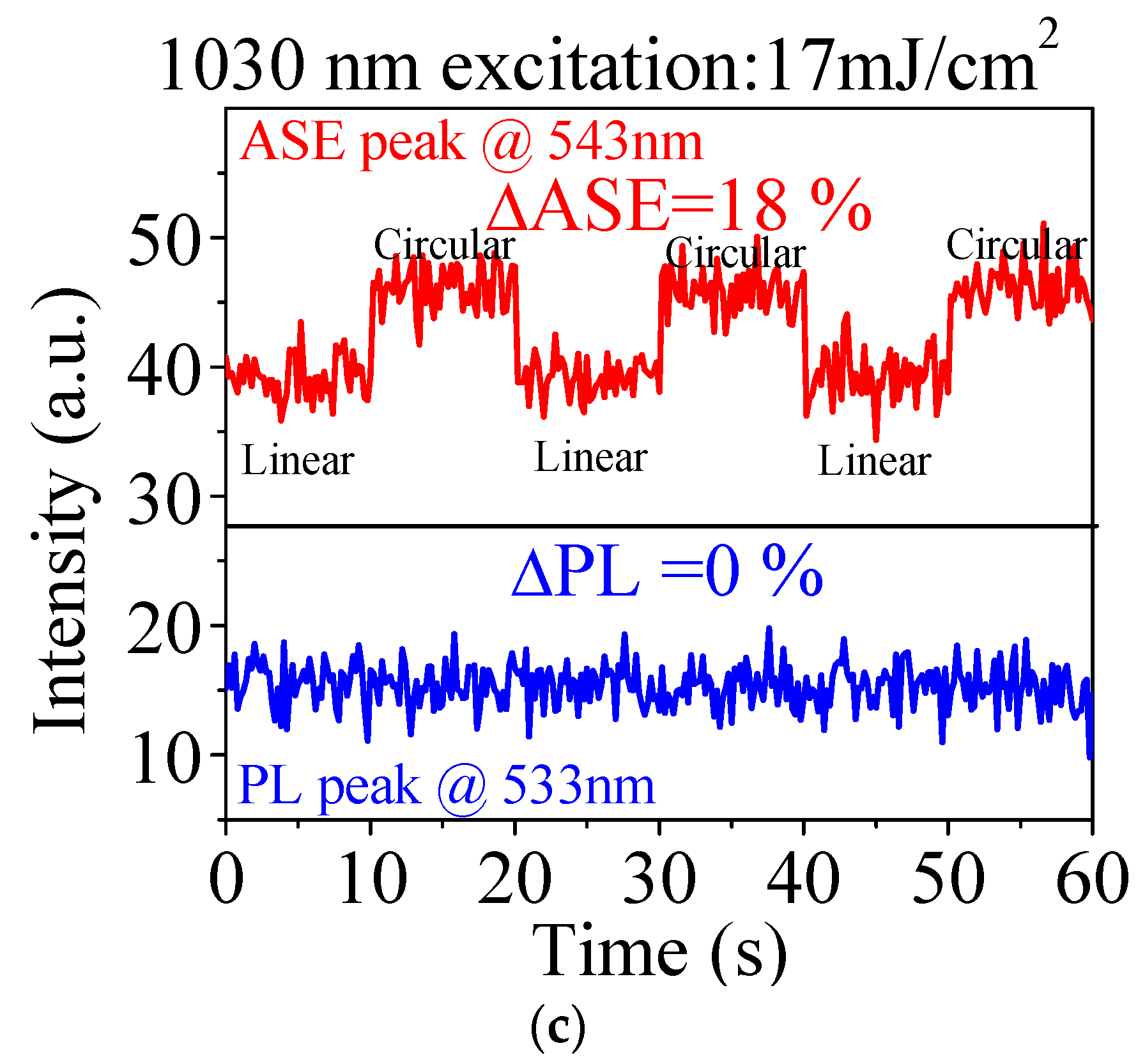Achieving Up-Conversion Amplified Spontaneous Emission through Spin Alignment between Coherent Light-Emitting Excitons in Perovskite Microstructures
Abstract
:1. Introduction
2. Materials and Methods
2.1. Materials
2.2. Characterizations
3. Results
3.1. Optical Characterizations
3.2. Up-Conversion ASE Emission Spectra
4. Discussion
5. Conclusions
Author Contributions
Funding
Institutional Review Board Statement
Informed Consent Statement
Data Availability Statement
Acknowledgments
Conflicts of Interest
References
- Snaith, H.J. Present status and future prospects of perovskite photovoltaics. Nat. Mater. 2018, 17, 372–376. [Google Scholar] [CrossRef] [PubMed]
- Jena, A.K.; Kulkarni, A.; Miyasaka, T. Halide perovskite photovoltaics: Background, status, and future prospects. Chem. Rev. 2019, 119, 3036–3103. [Google Scholar] [CrossRef] [PubMed]
- Zhu, H.; Fu, Y.; Meng, F.; Wu, X.; Gong, Z.; Ding, Q.; Gustafsson, M.V.; Trinh, M.T.; Jin, S.; Zhu, X. Lead halide perovskite nanowire lasers with low lasing thresholds and high quality factors. Nat. Mater. 2015, 14, 636–642. [Google Scholar] [CrossRef] [PubMed]
- Eaton, S.W.; Lai, M.; Gibson, N.A.; Wong, A.B.; Dou, L.; Ma, J.; Wang, L.-W.; Leone, S.R.; Yang, P. Lasing in robust cesium lead halide perovskite nanowires. Proc. Natl. Acad. Sci. USA 2016, 113, 1993–1998. [Google Scholar] [CrossRef] [PubMed] [Green Version]
- Lin, K.; Xing, J.; Quan, L.N.; De Arquer, F.; Gong, X.; Lu, J.; Xie, L.; Zhao, W.; Zhang, D.; Yan, C. Perovskite light-emitting diodes with external quantum efficiency exceeding 20 per cent. Nature 2018, 562, 245–248. [Google Scholar] [CrossRef] [PubMed]
- Cho, H.; Jeong, S.-H.; Park, M.-H.; Kim, Y.-H.; Wolf, C.; Lee, C.-L.; Heo, J.H.; Sadhanala, A.; Myoung, N.; Yoo, S. Overcoming the electroluminescence efficiency limitations of perovskite light-emitting diodes. Science 2015, 350, 1222–1225. [Google Scholar] [CrossRef]
- Dou, L.; Yang, Y.M.; You, J.; Hong, Z.; Chang, W.-H.; Li, G.; Yang, Y. Solution-processed hybrid perovskite photodetectors with high detectivity. Nat. Commun. 2014, 5, 5404. [Google Scholar] [CrossRef]
- Tian, W.; Zhou, H.; Li, L. Hybrid organic–inorganic perovskite photodetectors. Small 2017, 13, 1702107. [Google Scholar] [CrossRef]
- Xing, G.; Mathews, N.; Lim, S.S.; Yantara, N.; Liu, X.; Sabba, D.; Grätzel, M.; Mhaisalkar, S.; Sum, T.C. Low-temperature solution-processed wavelength-tunable perovskites for lasing. Nat. Mater. 2014, 13, 476–480. [Google Scholar] [CrossRef]
- Filip, M.R.; Eperon, G.E.; Snaith, H.J.; Giustino, F. Steric engineering of metal-halide perovskites with tunable optical band gaps. Nat. Commun. 2014, 5, 5757. [Google Scholar] [CrossRef] [Green Version]
- Xiao, Z.; Kerner, R.A.; Zhao, L.; Tran, N.L.; Lee, K.M.; Koh, T.-W.; Scholes, G.D.; Rand, B.P. Efficient perovskite light-emitting diodes featuring nanometre-sized crystallites. Nat. Photonics 2017, 11, 108–115. [Google Scholar] [CrossRef]
- Zhang, D.; Eaton, S.W.; Yu, Y.; Dou, L.; Yang, P. Solution-phase synthesis of cesium lead halide perovskite nanowires. J. Am. Chem. Soc. 2015, 137, 9230–9233. [Google Scholar] [CrossRef] [PubMed]
- Liu, F.; Zhang, Y.; Ding, C.; Kobayashi, S.; Izuishi, T.; Nakazawa, N.; Toyoda, T.; Ohta, T.; Hayase, S.; Minemoto, T. Highly luminescent phase-stable CsPbI3 perovskite quantum dots achieving near 100% absolute photoluminescence quantum yield. ACS Nano 2017, 11, 10373–10383. [Google Scholar] [CrossRef] [PubMed]
- Zhang, H.; Jin, M.; Liu, X.; Zhang, Y.; Yu, Y.; Liang, X.; Xiang, W.; Wang, T. The preparation and up-conversion properties of full spectrum CsPbX 3 (X= Cl, Br, I) quantum dot glasses. Nanoscale 2019, 11, 18009–18014. [Google Scholar] [CrossRef]
- Xu, Y.; Chen, Q.; Zhang, C.; Wang, R.; Wu, H.; Zhang, X.; Xing, G.; Yu, W.W.; Wang, X.; Zhang, Y. Two-photon-pumped perovskite semiconductor nanocrystal lasers. J. Am. Chem. Soc. 2016, 138, 3761–3768. [Google Scholar] [CrossRef]
- Yu, Z. Effective-mass model and magneto-optical properties in hybrid perovskites. Sci. Rep. 2016, 6, 28576. [Google Scholar] [CrossRef] [Green Version]
- Even, J.; Pedesseau, L.; Jancu, J.-M.; Katan, C. Importance of spin–orbit coupling in hybrid organic/inorganic perovskites for photovoltaic applications. J. Phys. Chem. Lett. 2013, 4, 2999–3005. [Google Scholar] [CrossRef] [Green Version]
- Zhu, X.; Xu, H.; Liu, Y.; Zhang, J.; Wang, M.; Ivanov, I.N.; Ovchinnikova, O.S.; Hu, B. Two-Photon Up-Conversion Photoluminescence Realized through Spatially Extended Gap States in Quasi-2D Perovskite Films. Adv. Mater. 2019, 31, 1901240. [Google Scholar] [CrossRef]
- Zhu, X.; Dai, S.-W.; Lai, Y.-L.; Dou, Y.; Wang, M.; Ho, J.-S.; Chang, Y.-A.; Chuang, Y.-T.; Lin, H.-W.; Hu, B. Packing-Shape Effects of Optical Properties in Amplified Spontaneous Emission through Dynamics of Orbit–Orbit Polarization Interaction in Hybrid Perovskite Quantum Dots Based on Self-Assembly. J. Phys. Chem. Lett. 2021, 12, 11894–11901. [Google Scholar] [CrossRef]
- Xu, H.; Prabhakaran, P.; Choi, S.; Wang, M.; Lee, K.-S.; Hu, B. Exploring Orbit–Orbit Interaction in Relationship to Photoluminescence Quantum Efficiency in Perovskite Quantum Dots through Rashba Effect. J. Phys. Chem. Lett. 2019, 11, 1–6. [Google Scholar] [CrossRef]
- Wang, M.; Zou, H.; Zhang, J.; Wu, T.; Xu, H.; Haacke, S.; Hu, B. Extremely Long Spin Lifetime of Light-Emitting States in Quasi-2D Perovskites through Orbit–Orbit Interaction. J. Phys. Chem. Lett. 2020, 11, 3647–3652. [Google Scholar] [CrossRef] [PubMed]
- Zhang, J.; Qin, J.; Wu, T.; Hu, B. Doping Induced Orbit–Orbit Interaction between Excitons While Enhancing Photovoltaic Performance in Tin Perovskite Solar Cells. J. Phys. Chem. Lett. 2020, 11, 6996–7001. [Google Scholar] [CrossRef] [PubMed]
- Cho, C.; Palatnik, A.; Sudzius, M.; Grodofzig, R.; Nehm, F.; Leo, K. Controlling and optimizing amplified spontaneous emission in perovskites. ACS Appl. Mater. Interfaces 2020, 12, 35242–35249. [Google Scholar] [CrossRef]
- Cho, C.; Zhao, B.; Tainter, G.D.; Lee, J.-Y.; Friend, R.H.; Di, D.; Deschler, F.; Greenham, N.C. The role of photon recycling in perovskite light-emitting diodes. Nat. Commun. 2020, 11, 611. [Google Scholar] [CrossRef] [PubMed] [Green Version]




Publisher’s Note: MDPI stays neutral with regard to jurisdictional claims in published maps and institutional affiliations. |
© 2022 by the authors. Licensee MDPI, Basel, Switzerland. This article is an open access article distributed under the terms and conditions of the Creative Commons Attribution (CC BY) license (https://creativecommons.org/licenses/by/4.0/).
Share and Cite
Zhu, X.; Xie, Y.; Ma, X. Achieving Up-Conversion Amplified Spontaneous Emission through Spin Alignment between Coherent Light-Emitting Excitons in Perovskite Microstructures. Photonics 2022, 9, 353. https://doi.org/10.3390/photonics9050353
Zhu X, Xie Y, Ma X. Achieving Up-Conversion Amplified Spontaneous Emission through Spin Alignment between Coherent Light-Emitting Excitons in Perovskite Microstructures. Photonics. 2022; 9(5):353. https://doi.org/10.3390/photonics9050353
Chicago/Turabian StyleZhu, Xixiang, Yulin Xie, and Xiaoling Ma. 2022. "Achieving Up-Conversion Amplified Spontaneous Emission through Spin Alignment between Coherent Light-Emitting Excitons in Perovskite Microstructures" Photonics 9, no. 5: 353. https://doi.org/10.3390/photonics9050353
APA StyleZhu, X., Xie, Y., & Ma, X. (2022). Achieving Up-Conversion Amplified Spontaneous Emission through Spin Alignment between Coherent Light-Emitting Excitons in Perovskite Microstructures. Photonics, 9(5), 353. https://doi.org/10.3390/photonics9050353






